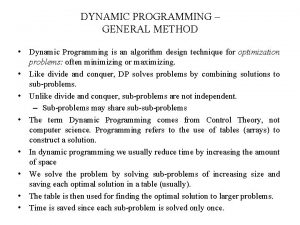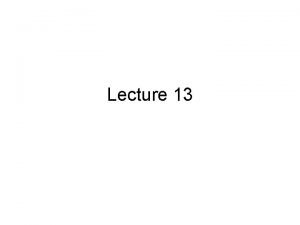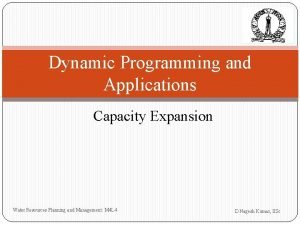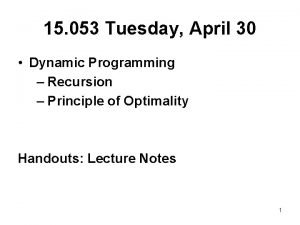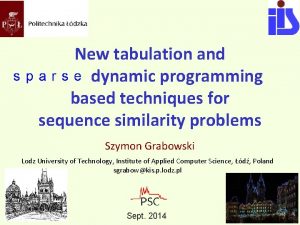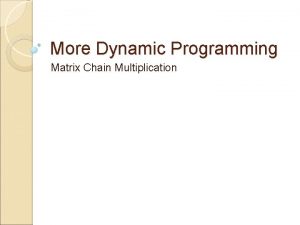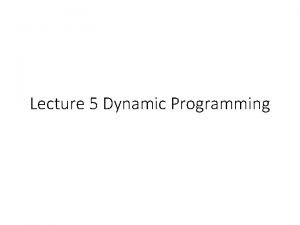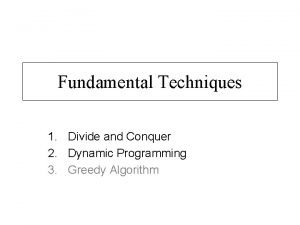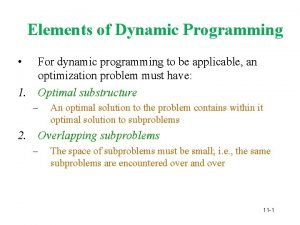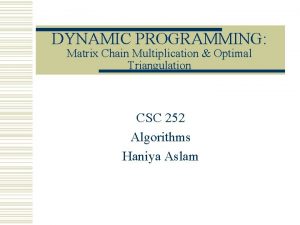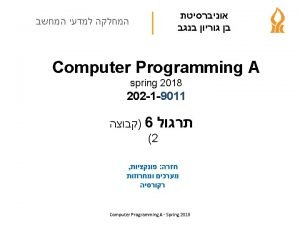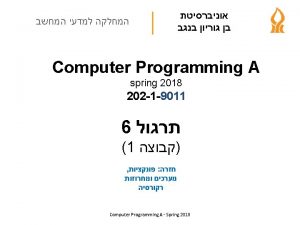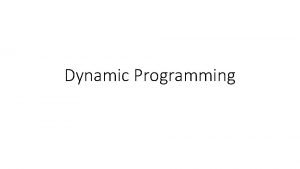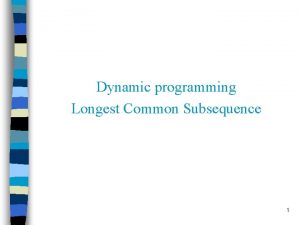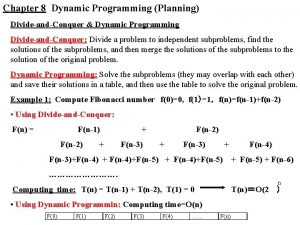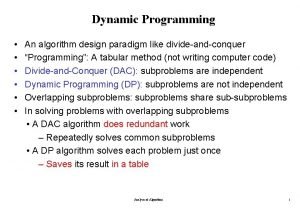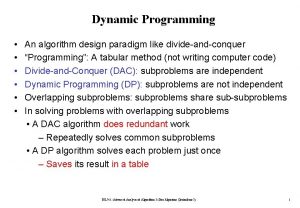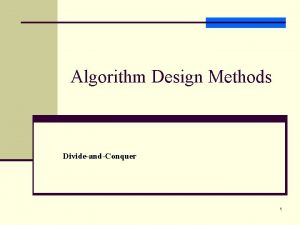Dynamic programming Design technique like divideandconquer Example Longest

![Brute-force LCS algorithm Check every subsequence of x[1. . m] to see if it Brute-force LCS algorithm Check every subsequence of x[1. . m] to see if it](https://slidetodoc.com/presentation_image_h/f4a9729ccf8d261c177010bb339142c0/image-2.jpg)

![Recursive formulation Theorem. c[i, j] = c[i– 1, j– 1] + 1 if x[i] Recursive formulation Theorem. c[i, j] = c[i– 1, j– 1] + 1 if x[i]](https://slidetodoc.com/presentation_image_h/f4a9729ccf8d261c177010bb339142c0/image-4.jpg)
![Proof (continued) Claim: z[1. . k– 1] = LCS(x[1. . i– 1], y[1. . Proof (continued) Claim: z[1. . k– 1] = LCS(x[1. . i– 1], y[1. .](https://slidetodoc.com/presentation_image_h/f4a9729ccf8d261c177010bb339142c0/image-5.jpg)

![Recursive algorithm for LCS(x, y, i, j) if x[i] = y[ j] then c[i, Recursive algorithm for LCS(x, y, i, j) if x[i] = y[ j] then c[i,](https://slidetodoc.com/presentation_image_h/f4a9729ccf8d261c177010bb339142c0/image-7.jpg)




- Slides: 11

Dynamic programming Design technique, like divide-and-conquer. Example: Longest Common Subsequence (LCS) • Given two sequences x[1. . m] and y[1. . n], find a longest subsequence common to them both. “a” not “the” x: A B C B D A B BCBA = LCS(x, y) y: B D C A B A functional notation, but not a function November 7, 2005 Copyright © 2001 -5 by Erik D. Demaine and Charles E. Leiserson
![Bruteforce LCS algorithm Check every subsequence of x1 m to see if it Brute-force LCS algorithm Check every subsequence of x[1. . m] to see if it](https://slidetodoc.com/presentation_image_h/f4a9729ccf8d261c177010bb339142c0/image-2.jpg)
Brute-force LCS algorithm Check every subsequence of x[1. . m] to see if it is also a subsequence of y[1. . n]. Analysis • Checking = O(n) time per subsequence. • 2 m subsequences of x (each bit-vector of length m determines a distinct subsequence of x). Worst-case running time = O(n 2 m) = exponential time. November 7, 2005 Copyright © 2001 -5 by Erik D. Demaine and Charles E. Leiserson

Towards a better algorithm Simplification: 1. Look at the length of a longest-common subsequence. !!! min of x and y. . 2. Extend the algorithm to find the LCS itself. Notation: Denote the length of a sequence s by | s |. Strategy: Consider prefixes of x and y. • Define LCS as c[i, j] = | LCS(x[1. . i], y[1. . j]) |. • c is the length of the common • Then, c[m, n] = | LCS(x, y) |. November 7, 2005 Copyright © 2001 -5 by Erik D. Demaine and Charles E. Leiserson
![Recursive formulation Theorem ci j ci 1 j 1 1 if xi Recursive formulation Theorem. c[i, j] = c[i– 1, j– 1] + 1 if x[i]](https://slidetodoc.com/presentation_image_h/f4a9729ccf8d261c177010bb339142c0/image-4.jpg)
Recursive formulation Theorem. c[i, j] = c[i– 1, j– 1] + 1 if x[i] = y[j], max{c[i– 1, j], c[i, j– 1]} otherwise. Proof. Case x[i] = y[ j]: x: 1 2 i m L = j n L Let z[1. . k] = LCS(x[1. . i], y[1. . j]), where c[i, j] = k. Then, z[k] = x[i], if it wasn’t included, needs to be appended for LCS, so extend z or if it could be longer (next case). Thus, z[1. . k– 1] must be the longest CS of x[1. . i– 1] and y[1. . j– 1]. y: November 7, 2005 Copyright © 2001 -5 by Erik D. Demaine and Charles E. Leiserson
![Proof continued Claim z1 k 1 LCSx1 i 1 y1 Proof (continued) Claim: z[1. . k– 1] = LCS(x[1. . i– 1], y[1. .](https://slidetodoc.com/presentation_image_h/f4a9729ccf8d261c177010bb339142c0/image-5.jpg)
Proof (continued) Claim: z[1. . k– 1] = LCS(x[1. . i– 1], y[1. . j– 1]). Suppose w is a longer CS of x[1. . i– 1] and y[1. . j– 1], that is, | w | > k– 1. Then, cut and paste: w || z[k] (w concatenated with z[k]) is a common subsequence of x[1. . i] and y[1. . j] with | w || z[k] | > k. Contradiction, proving the claim. Thus, c[i– 1, j– 1] = k– 1, which implies that c[i, j] = c[i– 1, j– 1] + 1. Other cases are similar. November 7, 2005 Copyright © 2001 -5 by Erik D. Demaine and Charles E. Leiserson

Dynamic-programming hallmark #1 Optimal substructure An optimal solution to a problem (instance) contains optimal solutions to subproblems. If z = LCS(x, y), then any prefix of z is an LCS of a prefix of x and a prefix of y. November 7, 2005 Copyright © 2001 -5 by Erik D. Demaine and Charles E. Leiserson
![Recursive algorithm for LCSx y i j if xi y j then ci Recursive algorithm for LCS(x, y, i, j) if x[i] = y[ j] then c[i,](https://slidetodoc.com/presentation_image_h/f4a9729ccf8d261c177010bb339142c0/image-7.jpg)
Recursive algorithm for LCS(x, y, i, j) if x[i] = y[ j] then c[i, j] LCS(x, y, i– 1, j– 1) + 1 else c[i, j] max{ LCS(x, y, i– 1, j), LCS(x, y, i, j– 1)} return c[i, j] Worst-case: x[i] ¹ y[ j], in which case the algorithm evaluates two subproblems, each with only one parameter decremented. November 7, 2005 Copyright © 2001 -5 by Erik D. Demaine and Charles E. Leiserson

Dynamic-programming hallmark #2 Overlapping subproblems A recursive solution contains a “small” number of distinct subproblems repeated many times. The number of distinct LCS subproblems for two strings of lengths m and n is only m n. November 7, 2005 Copyright © 2001 -5 by Erik D. Demaine and Charles E. Leiserson

Memoization algorithm Memoization: After computing a solution to a subproblem, store it in a table. Subsequent calls check the table to avoid redoing work. LCS(x, y, i, j) if c[i, j] = NIL then if x[i] = y[j] then c[i, j] LCS(x, y, i– 1, j– 1) + 1 else c[i, j] max{ LCS(x, y, i– 1, j), LCS(x, y, i, j– 1)} return c[i, j] same as before Time = Q(m n) = constant work per table entry. Space = Q(m n). November 7, 2005 Copyright © 2001 -5 by Erik D. Demaine and Charles E. Leiserson

Dynamic-programming algorithm IDEA: Compute the table bottom-up. Time = Q(m n). Reconstruct LCS by tracing backwards. November 7, 2005 B D C A B A A 0 0 1 1 0 0 0 0 1 B C B 0 0 0 1 1 1 1 2 2 2 2 3 2 2 D 0 1 2 2 2 3 3 3 Copyright © 2001 -5 by Erik D. Demaine and Charles E. Leiserson A 0 1 2 2 3 3 4 B 0 1 2 2 3 4 4

Dynamic-programming algorithm IDEA: Compute the table bottom-up. Time = Q(m n). Reconstruct LCS by tracing backwards. Space = Q(m n). Exercise: O(min{m, n}). November 7, 2005 B D C A B A A 0 0 1 1 0 0 0 0 1 B C B 0 0 0 1 1 1 1 2 2 2 2 3 2 2 D 0 1 2 2 2 3 3 3 Copyright © 2001 -5 by Erik D. Demaine and Charles E. Leiserson A 0 1 2 2 3 3 4 B 0 1 2 2 3 4 4
 Greedy vs dynamic programming
Greedy vs dynamic programming General method for dynamic programming
General method for dynamic programming Dynamic programming
Dynamic programming Dynamic programming recursion example
Dynamic programming recursion example Bh&m
Bh&m Dynamic dynamic - bloom
Dynamic dynamic - bloom Lcs tabulation
Lcs tabulation Matrix chain multiplication formula
Matrix chain multiplication formula Knapsack dynamic programming pseudocode
Knapsack dynamic programming pseudocode Dynamic programming bottom up
Dynamic programming bottom up Dynamic programming algorithm
Dynamic programming algorithm Dynamic programming vs divide and conquer
Dynamic programming vs divide and conquer

